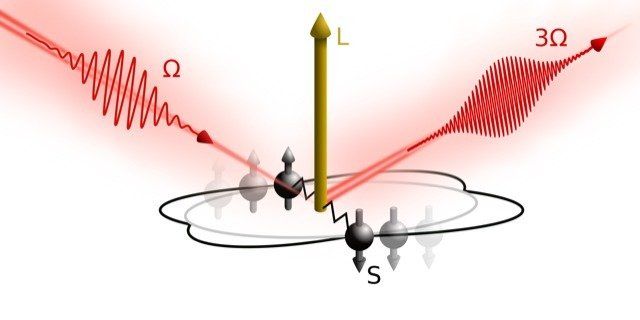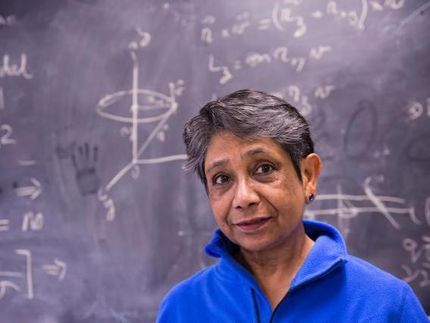The Higgs boson and superconductivity
New form of spectroscopy provides insights for the development of resistance-free current transport at ambient temperature
Advertisement
Without the Higgs mechanism, particles would have no mass. The Higgs boson, which was discovered in 2012, is therefore also referred to as the “God particle”. It arises as an oscillating excitation of the Higgs field, which penetrates the world. superconductivity displays similar properties. Their quantum mechanical wave, on which the electrons connected to form Cooper pairs essentially “surf”, can be excited to Higgs oscillations with a strong laser. These oscillations then emit a signal that provides complete information about this collective quantum state. This may help to unlock the mystery of high-temperature superconductivity. Higgs spectroscopy was developed by the international Max Planck-UBC-UTokyo Centre for Quantum Materials in which the Max Planck Institute for Solid State Research in Stuttgart is involved.

This is how the Higgs oscillations are excited in a superconductor. In the middle, the dumbbell-shaped Cooper pair (grey) can be seen. On the one hand, the terahertz laser pulse coming from the top left causes it to rotate, namely around the yellow axis with angular momentum L. It then begins to oscillate within itself as indicated by the zigzag-shaped spring in the diagram. These are the actual Higgs oscillations. This superposition leads to characteristic symmetries of vibration, especially in high-temperature superconductors. They emit a signal at three-fold the frequency of the laser. This signal contains complete information about the quantum mechanical state of superconductivity.
© MPI for Solid State Research
If superconductivity at ambient temperature were possible in technical applications, this could lead to enormous energy savings. When high-temperature superconductivity was discovered in the 1980s, it appeared that this would be feasible. But after the temperature records were initially broken, there were no further developments with respect to the temperature at which superconductivity occurs. The materials that become superconducting at high temperatures – especially the cuprates discovered back then – proved to be a hard nut to crack for theoretical physics. In contrast to conventional low-temperature superconductors, physicists have not been able to explain the extremely complex mechanism of high-temperature superconductivity. They do not yet understand why it is relatively temperature resistant and how it can be made even more tolerant to heat in order to make the materials suitable for everyday use.
A completely new experimental method, which the international cooperation Max Planck-UBC-UTokyo Centre for Quantum Materials has successfully used on high-temperature superconductors for the first time, could help here. This cooperation with the University of British Columbia (UBC) and the University of Tokyo was co-founded 10 years ago by Bernhard Keimer’s Department at the Max Planck Institute for Solid State Research in Stuttgart. At that time, it was clear that research into high-temperature superconductivity was a scientific marathon. The cooperation has endeavoured to solve this mystery.
Making the superconducting ground state transparent
Superconductivity is a field of research in solid state physics. Solid state physicists are struggling with the fundamental problem that the properties of the materials can be investigated only with indirect methods. This methodical problem has now been overcome using Higgs spectroscopy. “It can make the superconducting ground state – the desired quantum object – completely transparent”, says Stefan Kaiser. The physics professor heads the joint research group Ultrafast Solid State Spectroscopy of the Max Planck Institute for Solid State Research and the University of Stuttgart. The experiment, in which the method proved itself on high-temperature superconductors, took place at the Helmholtz Zentrum Dresden-Rossendorf, which is equipped with a powerful laser that emits radiation in the required terahertz range. This is the same sub-infrared electromagnetic radiation we see in body scanners at airports.
The theory leading to the development of the new Higgs spectroscopy was developed over 10 years by the team of Dirk Manske. It is particularly surprising that particle physics has provided essential ideas. “Looking into particle physics is the current trend in theoretical solid state physics”, says the physics professor, who is also a researcher at the Institute in Stuttgart. It worked well in this case.
Solid-state and particle physics complement each other
As early as the early 1960s, solid-state physics was complementing theoretical particle physics in the form of the recently deceased Nobel Prize winner in physics, Philip Anderson. Anderson was an outstandingly creative pioneer of solid state physics. He was also interested in particle physics. In 1962, he published a paper demonstrating how photons (or light quanta) obtain mass. This inspired Peter Higgs to publish his theory of the Higgs field in 1964 and led to him and François Englert being awarded the Nobel Prize for Physics in 2013.
“In solid-state physics, we speak of the Anderson-Higgs mechanism”, says Kaiser. Higgs spectroscopy has now brought these ideas back into solid state physics. Like the Higgs boson, the Cooper pairs, which are each formed from two electrons and carry superconductivity, belong to the quantum mechanical family of bosons. Bosons tend to assemble in a common quantum state. The Cooper pairs form a large quantum mechanical wave, a collective quantum object that can move through the superconductor as an electric current without friction.
The Cooper pairs can be thought of as dumbbells. The electrons correspond to the weights, and the connection between them is the handle. “But it functions more like a spring”, stresses Manske. The electrons in the Cooper pair can thus oscillate against or with each other. “These are the Higgs oscillations”, explains the theorist. “For a long time, it was not clear whether they were even excitable in Cooper pairs”. But that’s exactly what Higgs spectroscopy does. Using a powerful terahertz laser beam at the appropriate frequency, it forces the Cooper pair dumbbells to vibrate and makes them rotate. The collective of the Cooper pairs behaves like a stringed instrument that also produces overtones with its resonating body. “The superconducting pairs then oscillate at twice the frequency of the laser light and exhibit characteristic symmetries”, explains Kaiser. “In doing so, they send out a signal at three-fold the frequency”.
Loose engagement of the Cooper couples
The clincher: this signal now contains complete information about the quantum object of the superconducting ground state. The novel aspect of Higgs spectroscopy is that it suddenly makes superconductivity transparent to the outside world. This also increases the researchers’ hopes of finally gaining a better understanding of the extremely temperature-resistant pairing mechanism of high-temperature superconductivity.
The initial results on different cuprate superconductors show that even above the temperature at which superconductivity occurs, some electrons join together to form a kind of pre-formed Cooper pair. A more detailed understanding of this loose engagement of electrons even before the real Cooper pair union could perhaps open a path to superconductivity at ambient temperature. With Higgs spectroscopy, there has indeed been a “quantum leap” in superconductivity research.
Original publication
L. Schwarz, B. Fauseweh, N. Tsuji, N. Cheng, N. Bittner, H. Krull, M. Berciu, G. S. Uhrig, A. P. Schnyder, S. Kaiser und D. Manske; "Classification and characterization of nonequilibrium Higgs modes in unconventional superconductors"; Nature Communications; 11 January 2020.
H. Chu et al.; "Phase-resolved Higgs response in superconducting cuprates"; Nature Communications; 14 April 2020.
Other news from the department science
Most read news
More news from our other portals
See the theme worlds for related content
Topic World Spectroscopy
Investigation with spectroscopy gives us unique insights into the composition and structure of materials. From UV-Vis spectroscopy to infrared and Raman spectroscopy to fluorescence and atomic absorption spectroscopy, spectroscopy offers us a wide range of analytical techniques to precisely characterize substances. Immerse yourself in the fascinating world of spectroscopy!

Topic World Spectroscopy
Investigation with spectroscopy gives us unique insights into the composition and structure of materials. From UV-Vis spectroscopy to infrared and Raman spectroscopy to fluorescence and atomic absorption spectroscopy, spectroscopy offers us a wide range of analytical techniques to precisely characterize substances. Immerse yourself in the fascinating world of spectroscopy!


































































